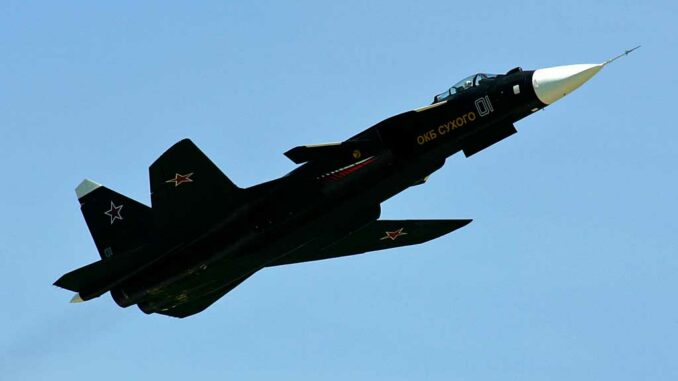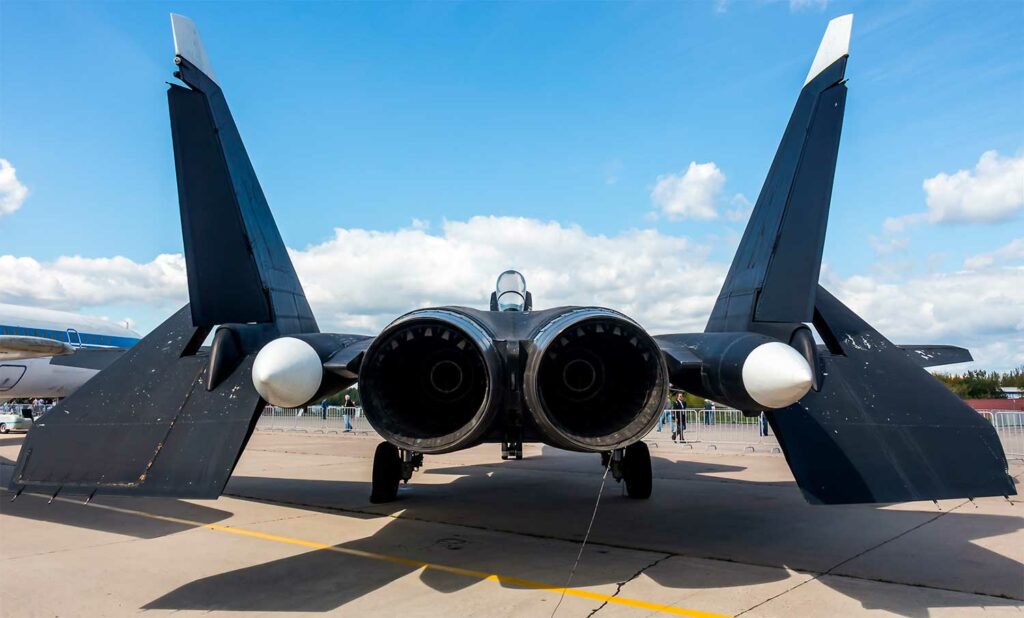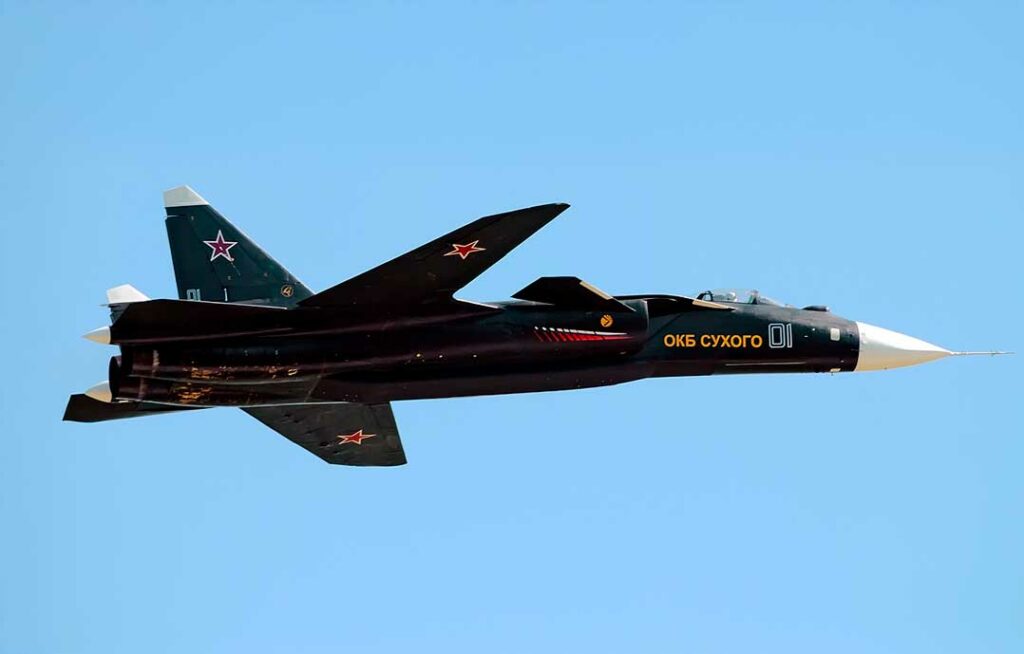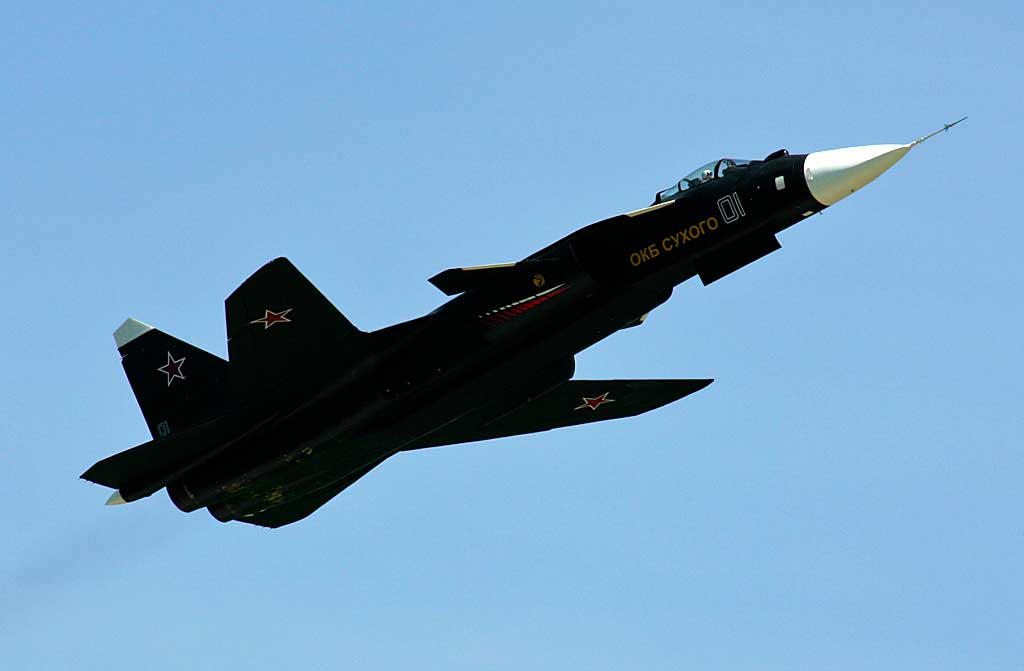
Discover 10 little-known technical facts about the Sukhoi Su-47 Berkut, a Russian fighter jet with inverted wings, designed as a technology demonstrator.
The Sukhoi Su-47 Berkut, also known as the Golden Eagle, is one of the most daring projects in Russian military aviation. Developed in the late 1990s by the Sukhoi design bureau, this prototype fighter jet stands out for its unique inverted wing configuration, a rarity in the history of modern military aviation. Designed as a technology demonstrator, it was never intended for mass production, but served as a flying laboratory to test innovations for future Russian fighter jets, notably the Su-57. Despite its experimental status, the Su-47 attracted the attention of experts and enthusiasts for its radical technical choices, exceptional maneuverability, and stealth technologies under development.
1. Swept-back wings, a major aerodynamic challenge
The Sukhoi Su-47 Berkut is immediately recognizable by its inverted swept wings, which are angled forward. This design offers several aerodynamic advantages, including increased lift at low speeds, better maneuverability at slow speeds, and superior stability at high angles of attack. Unlike conventional wings, swept wings generate fewer vortices at the wing tips, which improves flight efficiency.
However, this layout also has serious drawbacks. The major constraint is reverse torsion: at high speeds, the wing tips tend to twist upward, threatening structural stability. To compensate for this, Sukhoi had to make extensive use of composite materials, which are capable of withstanding these loads while remaining lightweight. This choice places the Su-47 among the few experimental military aircraft to have incorporated this configuration, alongside projects such as the American X-29. This bold concept was never selected for a production aircraft due to its structural complexity and development costs.

2. A structure made of more than 90% composite materials
In order to meet the mechanical requirements imposed by the inverted V-shaped wings, Sukhoi engineers built the Su-47’s airframe using more than 90% composite materials. These elements include carbon fibers, reinforced polymers, and special alloys, all selected for their exceptional strength-to-weight ratio.
The goal was to make the aircraft rigid, lightweight, and capable of absorbing the torsional stresses generated during extreme maneuvers. This decision also reduces the radar signature, as composite materials are partially absorbent to electromagnetic waves. At the time, this proportion of advanced materials represented a technological breakthrough in Russian combat aviation, even surpassing some Western standards.
This technological choice helped make the Sukhoi Su-47 Berkut a test platform ahead of its time, although it could not be industrialized in its current form. The complexity of mass production and the associated costs limited its application to future programs such as the Su-57.
3. A technology demonstrator, not an operational aircraft
Contrary to what its aggressive appearance might suggest, the Sukhoi Su-47 Berkut was never designed for deployment in combat units. It was primarily a flying test bed, intended to experiment with future fighter aircraft technologies. The aircraft was developed as part of the PAK FA (Perspektivny Aviatsionny Kompleks Frontovoy Aviatsii) program, prior to the development of the Su-57.
It enabled advanced concepts in aerodynamics, materials, cockpit ergonomics, and extreme maneuverability to be tested. The lessons learned from the Su-47 were crucial in guiding subsequent industrial choices. Its status as a prototype also explains why only one example was built and why it was never integrated into the Russian Air Force.
Nevertheless, the experience gained helped position Sukhoi at the forefront of innovation programs, giving it a strategic advantage over its Western competitors in certain technological areas such as thrust vectoring and stealth architecture.
4. A confusing designation: S-37 or Su-47?
Initially, the project was known as S-37, a name used by Sukhoi during its first press presentations in the 1990s. This designation corresponded to the manufacturer’s internal system, with S standing for “samolyot” (aircraft), followed by a project number.
It was only later, when it became more closely integrated into official Russian military demonstrations, that the prototype was renamed Su-47, in line with the standard nomenclature for Sukhoi fighter aircraft. However, this designation was never official in Russian military doctrine, which did not select the Berkut as a fighter aircraft.
This ambiguity helped to maintain the mystique surrounding the Su-47, reinforced by its rarity and widespread speculation about its actual capabilities. Even today, specialist publications alternate between the two names depending on the context.

5. First flight in 1997 amid crisis
The first flight of the Sukhoi Su-47 Berkut took place on September 25, 1997, at a time when Russia was experiencing major economic and political difficulties. The very survival of the program was a feat in itself, financed in part by Sukhoi with internal resources and limited state support.
This maiden flight remained low-key, and it was not until the 1999 MAKS air show that the aircraft was officially unveiled to the public. This context explains the delay in media coverage of the project, despite its technical advances. The Su-47 nevertheless continued to fly sporadically in the 2000s for specific test campaigns.
This program has gone down in history as an example of industrial resilience, demonstrating the Russian aerospace industry’s ability to innovate despite a constrained budgetary environment.
6. Provisional thrust vector engines
The Sukhoi Su-47 Berkut never received the new-generation engines originally planned for it. Due to a lack of funding and the development schedule of the PAK FA program, the aircraft was equipped with two AL-37FU turbojet engines, a modified version of the AL-31F engine that powers the Su-27. These engines were equipped with unidirectional thrust vector nozzles, allowing partial control of thrust on the pitch axis.
Although limited compared to later three-dimensional systems, this technology already gave the Su-47 impressive maneuverability, particularly at low speeds and during aerobatic maneuvers. However, these engines did not allow the Berkut to demonstrate its full potential, as it was originally designed for more powerful engines with thrust vectoring on multiple axes.
The use of temporary engines limited certain performance characteristics, but was sufficient to validate the aircraft’s overall aerodynamics and extreme capabilities in close combat, an area where the Sukhoi Su-47 Berkut theoretically excels due to its agility.
7. Extreme maneuverability thanks to thrust vectoring
The Sukhoi Su-47 Berkut was designed to achieve unmatched maneuverability in close combat. Combining the advantages of reverse wings with thrust vectoring, the aircraft could perform maneuvers such as instant turns, very tight loops, and even “Pugachev’s Cobra” and “Kulbit” maneuvers.
This agility was a major theoretical advantage in dogfights, allowing it to gain the upper hand over an opponent in confined airspace. The aircraft’s design also reduced the risk of stalling at high angles, a common problem in conventional configurations.
This performance allowed Sukhoi to validate many technologies for future Russian fighter aircraft, including digital flight control systems, artificial stability, and coordination between aerodynamic controls and thrust vectoring.

8. Stealth testing without being a stealth aircraft
The Su-47 was never a true stealth aircraft, but it served as a laboratory for several radar signature reduction technologies. The aircraft incorporated specific aerodynamic shapes to limit frontal radar reflections, including S-shaped air intakes and smoothed leading edges.
Absorbent coatings were also applied to certain parts of the airframe, including the engine nacelles, wing leading edges, and fuselage. These composite materials contributed to a partial reduction in radar signature, without reaching the levels of a fifth-generation stealth aircraft such as the F-22 Raptor or the Su-57.
The Sukhoi Su-47 Berkut therefore played a discreet but crucial role in the evolution of the stealth capabilities of future Russian fighter aircraft. It made it possible to evaluate the effectiveness of the first passive radar reduction technologies in real flight conditions.
9. A cockpit optimized for high-acceleration combat
The Su-47’s cockpit featured an innovation rarely seen in Russian fighter jets at the time: a seat tilted 30° backward, designed to reduce the effects of high acceleration on the pilot’s body. This ergonomic configuration improves human tolerance to positive G-forces, facilitating extreme maneuvers without loss of consciousness.
The cockpit was equipped with a new-generation head-up display (HUD), HOTAS (Hands On Throttle And Stick) controls, and computer-assisted flight systems, essential for controlling a naturally unstable aircraft such as the Su-47. The pilot thus benefited from an environment designed for intensive air combat, with improved situational awareness.
These elements, successfully tested on the Berkut, were adopted and refined in subsequent generations of Russian aircraft, notably the Su-35S and Su-57, where the human factor became a central parameter in combat aircraft design.
10. A unique prototype, preserved as a museum piece
Only one complete Sukhoi Su-47 Berkut was built and used for flight testing. After several years of testing, the aircraft was withdrawn from active service in the 2010s. It is now preserved at the Zhukovsky Aviation Museum near Moscow, alongside other Soviet and Russian experimental prototypes.
This status as a one-of-a-kind aircraft reinforces its almost mythical aura. It symbolizes a period of transition in the Russian defense industry, when innovation had to break free from budgetary constraints and rely on radical concepts to remain competitive with Western powers.
The Berkut thus remains a symbol of technological daring, whose legacy can be found today in the advanced capabilities of Russian fighter jets. Its indirect contribution to the Su-57 makes it an important milestone in the modern history of military aviation.
War Wings Daily is an independant magazine.